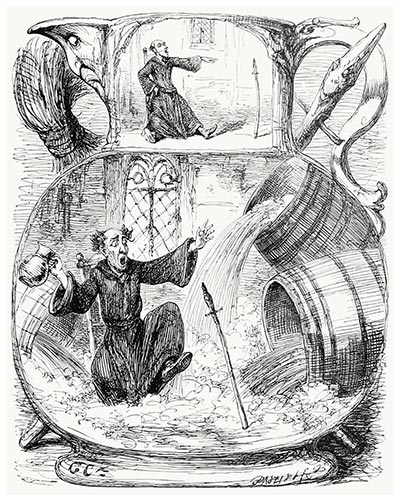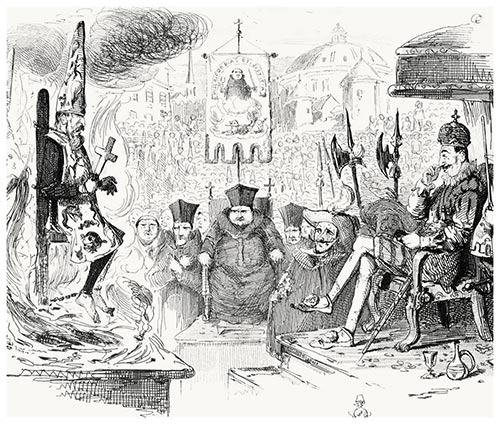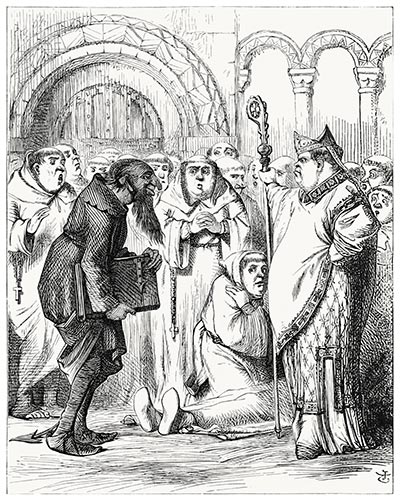The Ingoldsby Legends

Ingoldsby Legends. (1 vol. 4to. Richard Bentley.) A work illustrated by Cruikshank, Leech, and Tenniel, even if it had no intrinsic merits of its own, would stand a very fair chance of immortality; but when the three great artists combine simply to embellish what would otherwise live as long as the English language, as long as humour and pathos, exquisite versification, and singular felicity as well as facility of rhyme, are appreciated, it seems superfluous to do more than inform the public what a prize is within their reach. And, if this be not enough, there is more to be said in favour of the noble specimen of bibliopolic art which we have been permitted to admire in deshabille—that is to say, ere it has assumed the full-dress binding in which it will make its appearance before those who will be the ultimate arbiters of its fate. It is printed upon the most delicately-tinted paper, and its type is of the most pleasing character: it is, in fact, a gem of elegance. The present edition outshines former editions as undeniably as the bride, magnificent in wedding-dress and fresh from the breeze of mountain or sea, surpasses in loveliness the jaded belle of a protracted season. The pallid, wan, and roughened complexion is exchanged for a sweetly-coloured and satin-like surface. Of the sixty illustrations with which the book is adorned by far the greater number are entirely new. Subjoined the reader will find a specimen of each famous draughtsman's style.

In the scene from the "Auto-da-fé" we recognise with a smile of welcome a very old friend, drawn by the cunning pencil of John Leech. There sits King Ferdinand, as of old, "leaning back in his chair with a satisfied air," whilst "his pouncet-box goes to-and-fro at his nose," and then throng the "fair ladies from Xeres and Cadiz," to see "the last wretched Hebrew burnt down in his socket" as smilingly as they would crowd to a bull-fight. George Cruikshank's quaint and graphic illustration of a well-known scene from the "Lay of St. Dunstan" is not familiar to us, and will no doubt be equally unfamiliar and equally grateful to the reader. The story is excellently and succinctly told of what befel the unhappy lay brother for daring to conjure with saintly secrets, little dreaming what Clarence-like fate would be his as he shouted, "Broomstick! you lubberly son of a gun! bring ale!—bring a flagon—a hogshead—a tun!"

Quite new, also, to us is the specimen of Tenniel's masterly handiwork illustrative of a position in the "Brothers of Birchington." The artist has succeeded admirably in depicting, by the faces and positions of his figures, the double character—the humour and seriousness, all in one—of "Thomas Ingoldsby's" words: the obesity and imperiousness of St. Thomas A'Becket, and the mingled surprise, horror, and "funk" of the monks, and tradesman-like complaisance expressed in the countenance of "Auld Hornie" are uncommonly amusing. The moment chosen is that which follows upon the stroke of the pastoral crook upon the pavement, when Eulus shakes, and, "hanging his ears, yet dissembling his fears, ledger in hand, straight 'Auld Hornie' appears, With that sort of half-sneaking, half-impudent look bankrupts sport when cross-questioned by Cresswell or Cooke." To conclude, it may be fairly predicted that this superb edition of "Mirth and Marvels" will be inferior to none of those exquisite literary and artistic treasures which come forth at Christmas from the storehouses of publishers.
This article was taken from the Illustrated London News vol. 43 (July to December 1863). London: George C. Leighton.
